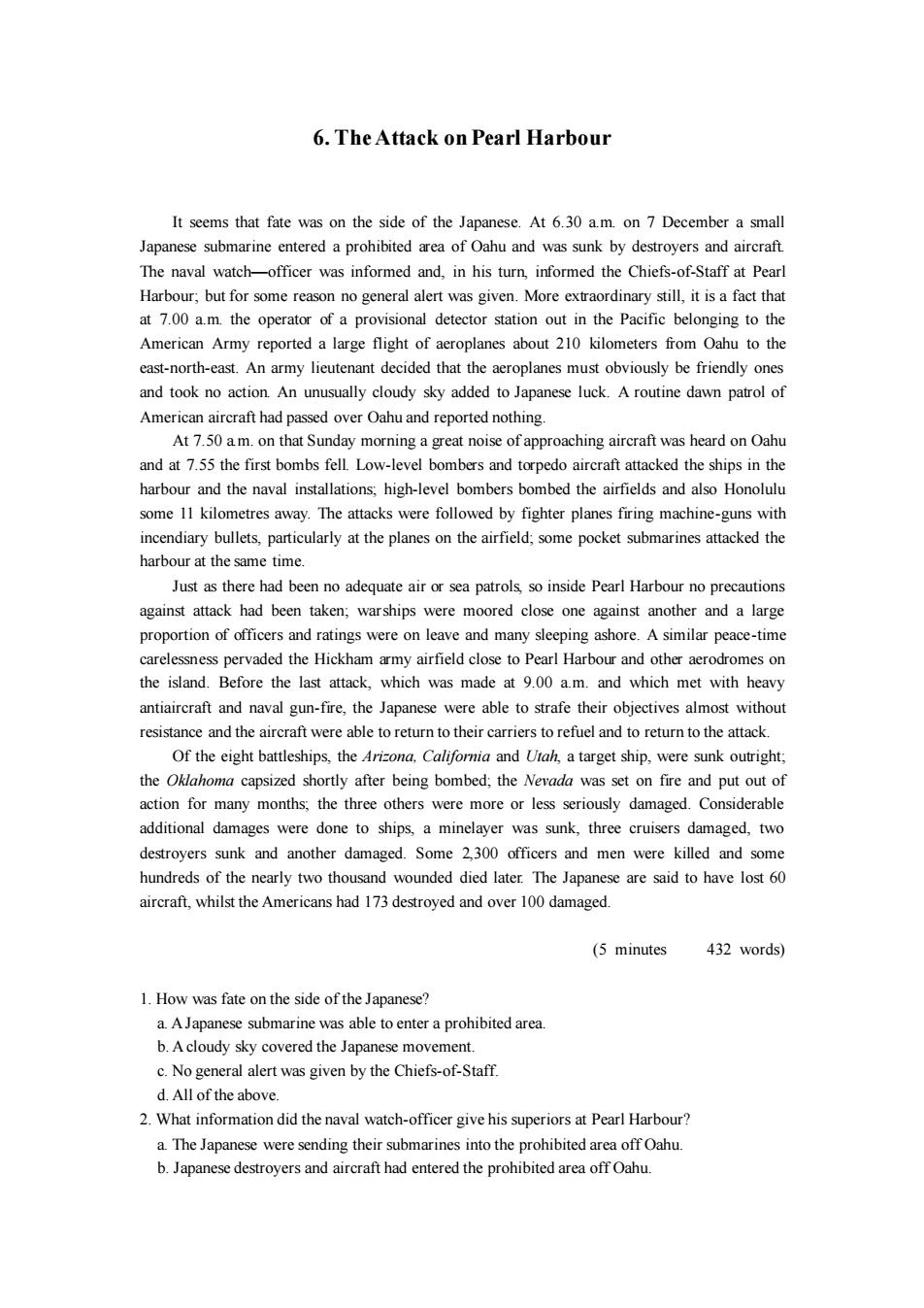正在加载图片...

6.The Attack on Pearl Harbour It seems that fate was on the side of the Japanese.At 6.30 am.on 7 December a small Japanese submarine entered a prohibited area of Oahu and was sunk by destroyers and aircraft The naval watchofficer was informed and,in his turn informed the Chiefsof-Staff at Pearl Harb our,but for me reo no general alert was given.Morex rdinary still,it is fact th at 7.00 a.m the operator of a provisional detector station out in the Pacific belonging to the American Army reported a large flight of acroplanes about 210 kilometers from Oahu to the east-north-east.An army lieutenant decided that the aeroplanes must obviously be friendly ones and took no action.An unusually cloudy sky added to Japanese luck.A routine dawn patrol of Amer over Oahu u and At7.that Sunday nose of approaching aircraft was and at 7.55 the first bombs fell.Low-level bombers and torpedo aircraft attacked the ships in the harbour and the naval installations,high-level bombers bombed the airfields and also Honolulu some 11 kilometres away.The attacks were followed by fighter planes firing machine-guns with ncendiary bullets,particularly at the planes on the airfield. ocket su harbour at th Just as there had been no adequate air or sea patrols so inside Pearl Harbour no precautions against attack had been taken:warships were moored close one against another and a large proportion of officers and ratings were on leave and many sleeping ashore.A similar peace-time carelessness pervaded the Hickham army airfield close to Pearl Harbour and other aerodromes on the island.Before the last attack ich wa made at 9.00 which met vith antiaircraft and naval gun-fire,the Japanese were able to strafe their objectives almost without resistance and the aircraft were able to return to their carriers to refuel and to return to the attack Of the eight battleships,the Arizona.Califomia and Utah,a target ship,were sunk outright. the Oklahoma capsized shortly after being bombed,the Nevada was set on fire and put out of action for many months,the three t were more or less seriously damaged Considerable additional damages were done to ships,a minelaye was sunk. three cruisers maged,two destroyers sunk and another damaged.Some 2300 officers and men were killed and some hundreds of the nearly two thousand wounded died later The Japanese are said to have lost 60 aircraft.whilst the Americans had 173 destroved and over 100 damaged. (5minutes 432 words) 1.How was fate on the side of the Japanese? a.AJapanese submarine was able to enter a prohibited area. b.A cloudy sky covered the Japanese movement. e no ge eral alert was given by the Chiefs-of-Staff d.All of the above 2.What information did the naval watch-officer give his superiors at Pearl Harbour? a.The Japanese were sending their submarines into the prohibited area offOahu. b.Japanese destroyers and aircraft had entered the prohibited area offOahu 6. The Attack on Pearl Harbour It seems that fate was on the side of the Japanese. At 6.30 a.m. on 7 December a small Japanese submarine entered a prohibited area of Oahu and was sunk by destroyers and aircraft. The naval watch—officer was informed and, in his turn, informed the Chiefs-of-Staff at Pearl Harbour; but for some reason no general alert was given. More extraordinary still, it is a fact that at 7.00 a.m. the operator of a provisional detector station out in the Pacific belonging to the American Army reported a large flight of aeroplanes about 210 kilometers from Oahu to the east-north-east. An army lieutenant decided that the aeroplanes must obviously be friendly ones and took no action. An unusually cloudy sky added to Japanese luck. A routine dawn patrol of American aircraft had passed over Oahu and reported nothing. At 7.50 a.m. on that Sunday morning a great noise of approaching aircraft was heard on Oahu and at 7.55 the first bombs fell. Low-level bombers and torpedo aircraft attacked the ships in the harbour and the naval installations; high-level bombers bombed the airfields and also Honolulu some 11 kilometres away. The attacks were followed by fighter planes firing machine-guns with incendiary bullets, particularly at the planes on the airfield; some pocket submarines attacked the harbour at the same time. Just as there had been no adequate air or sea patrols, so inside Pearl Harbour no precautions against attack had been taken; warships were moored close one against another and a large proportion of officers and ratings were on leave and many sleeping ashore. A similar peace-time carelessness pervaded the Hickham army airfield close to Pearl Harbour and other aerodromes on the island. Before the last attack, which was made at 9.00 a.m. and which met with heavy antiaircraft and naval gun-fire, the Japanese were able to strafe their objectives almost without resistance and the aircraft were able to return to their carriers to refuel and to return to the attack. Of the eight battleships, the Arizona, California and Utah, a target ship, were sunk outright; the Oklahoma capsized shortly after being bombed; the Nevada was set on fire and put out of action for many months; the three others were more or less seriously damaged. Considerable additional damages were done to ships, a minelayer was sunk, three cruisers damaged, two destroyers sunk and another damaged. Some 2,300 officers and men were killed and some hundreds of the nearly two thousand wounded died later. The Japanese are said to have lost 60 aircraft, whilst the Americans had 173 destroyed and over 100 damaged. (5 minutes 432 words) 1. How was fate on the side of the Japanese? a. A Japanese submarine was able to enter a prohibited area. b. A cloudy sky covered the Japanese movement. c. No general alert was given by the Chiefs-of-Staff. d. All of the above. 2. What information did the naval watch-officer give his superiors at Pearl Harbour? a. The Japanese were sending their submarines into the prohibited area off Oahu. b. Japanese destroyers and aircraft had entered the prohibited area off Oahu